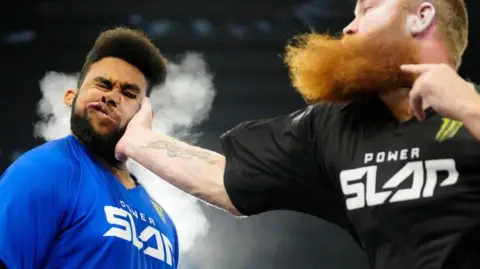[ad_1]
 Icon Sportswire / Contributor
Icon Sportswire / ContributorDoctors are concerned that a combat sport called slap fighting, watched by millions online and gaining in popularity, is causing serious brain damage.
Competitors meet and take turns to deliver bare blows, full of strength and open hands to the cheek.
To assess the possible damage, doctors have screened videos of tournaments and have now written a warning letter in a leading newspaper, JAMA Surgeryon his findings.
Unlike boxing, no equipment is allowed and defenders cannot duck to avoid blows. Even flinching is forbidden.
Opponents are scored based on the amount of damage they deal and how well they do at being knocked down.
The sport is popular in the United States, but other countries, including the United Kingdom, are getting in on the action.
Next month, Liverpool are holding what has been billed as Britain’s first heavyweight competition Slap Fight.
The “adrenaline night like no other” sees Louis “The Razor” Robinson take on Dom “The Juggernaut” Sorby.
Experts from the University of Pittsburgh School of Medicine in the United States say that theirs is the only academic study to quantitatively evaluate the possible dangers.
It’s not the first public warning about the sport though.
 Getty Images/Gaelen Morse
Getty Images/Gaelen MorseThe alarm was raised in 2021 after the Polish fighter Artur Walczak suffered a cerebral hemorrhage during a match in which he was defeated and lost consciousness.
Despite hospital treatment, he died weeks later of multiple organ failure related to his head injury.
And in March 2023, retired female wrestler Kortney Olson shared her slap-fight story with BuzzFeed News.
During a showcase for contestants on a now-cancelled cable network show, Power Slap, Olsen is hit by contestant Sheena Bathory and falls, her eyes visibly welling up as the crowd gasps.
Olsen said in an interview that she was worried about memory lapses both during the match and months later: “After I regained consciousness, I got up to get to the table and reset, but I lost consciousness again and it ended to roll forward. I don’t remember rolling forward.”
The lead authors of the medical study, Dr. Raj Swaroop Lavadi and Dr. Nitin Agarwal, say that while slap fighting “could be fun to watch,” as medical professionals, “we found some aspects of the competitions quite worrying”.
According to his analysis of 78 fights between 56 competitors and involving 333 slaps:
- more than half of the participants had visible signs of concussion
- many had signs of impaired movement after a stroke or had a blank or vacant stare
- some were knocked down they had some difficulty getting back
Many of the fights they observed were in the United States, where big events attracted stars like Arnold Schwarzenegger and Logan Paul, to watch and comment from the sidelines.
When asked at “ringside” if he had any advice for the two female contenders, Mr. Schwarzenegger said: “No, I’m just learning now. This is the first time I’ve seen any of this live.”
Such events are often broadcast on YouTube.
What is concussion?
A concussion is a traumatic injury that can occur with a blow to the head as the brain moves through the hard skull.
There may be short-term headaches, blurred vision, vomiting, slurred speech, drowsiness or confusion and problems with memory, balance, mood or sleep.
A single concussion will not usually cause permanent damage, but repeated ones over a lifetime can be extremely serious.
Repeated blows to the head can cause something called chronic traumatic encephalopathy, or CTE, which worsens over time and can lead to dementia.
Many contact sports, such as rugby, have concussion protocols and guidelines to help protect players.
FIFA and the World Health Organization have launched a new awareness campaign “Suspect and Protect” to increase recognition among footballers.
FIFA president Gianni Infantino said: “Concussion is a brain injury and should always be taken seriously.
“By knowing the signs, being aware of the risks and treating concussion correctly, you can help put player safety first.”
Anyone who has an injury that affects the head, face, neck or body should have a medical check for concussion symptoms, which can take several days to appear.
One of the Pittsburgh medical team, Dr. Joseph Maroon, co-developed the rigorous concussion screenings used by the US National Football League, the National Hockey League and Major League Baseball to ensure that players are fit for keep playing.
He told BBC News: “In the past, it was thought that you don’t have a concussion unless you have a loss of consciousness. We now know that 90% happen in the absence of loss of consciousness.”
He said that slap fighting presented an obvious risk and that guidance was needed.
“The worst possible thing to do in terms of possible brain damage is to return to a contact sport before the brain has fully recovered … the brain is more susceptible to damage with less force,” he said.
“So for an individual who has experienced a concussion and then gets up and gets hit again, it puts the athlete at increased risk.”
